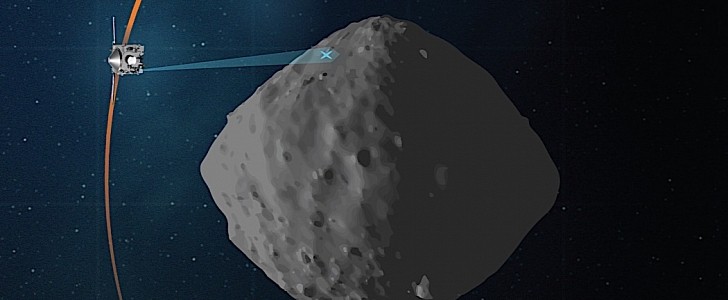It may very well be the first time in history humanity managed to leave a mark on an asteroid freely roaming the expanse of our solar system, and in about a week’s time, the world will know just how big of a mark that was.
Back in 2016, NASA launched into space a spaceship with a long and tongue-twisting name. The Origins, Spectral Interpretation, Resource Identification, Security, Regolith Explorer (commas are part of the name, and we’ll call it OSIRIS from now on, as does NASA) was dispatched to catch up with a piece of rock called Bennu.
The ship’s mission was to land, pinch the asteroid, and then head back home with some pieces of it for our scientists to analyze and learn more about the formation of the solar system and Earth as a habitable planet. OSIRIS completed its task magnificently. In fact, it might have gone overboard with it.
To put it simply, collecting the asteroid samples involved nitrogen gas canisters and articulated arms, so the entire procedure was not by any means soft.
NASA completed the procedure a while back and managed to snatch probably over 2 ounces (60 grams) of asteroid material. But before heading home, Earth instructed OSIRIS to conduct another flyby of the asteroid and assess “the mess it made on asteroid Bennu’s surface.”
According to the agency, “Bennu’s surface was significantly disturbed by the sample collection event.” The sampling head of the OSIRIS sunk 1.6 feet (48.8 centimeters) into it during touchdown, and the subsequent firing of the pressurized tanks really took its toll. Also, there was probably disturbance caused by the firing of the thrusters as the spaceship took off once its mission was over.
NASA says the weak gravity on Bennu might have amplified the effects of the sample collection procedure and plans to see exactly how much on April 7, when the flyby will occur at a distance of 2.3 miles (3.7 km) from the surface.
OSIRIS will continue to spin around the asteroid until May 10, when it will begin its long journey home. It is scheduled to land in September 2023 at the Utah Test and Training Range.
The ship’s mission was to land, pinch the asteroid, and then head back home with some pieces of it for our scientists to analyze and learn more about the formation of the solar system and Earth as a habitable planet. OSIRIS completed its task magnificently. In fact, it might have gone overboard with it.
To put it simply, collecting the asteroid samples involved nitrogen gas canisters and articulated arms, so the entire procedure was not by any means soft.
NASA completed the procedure a while back and managed to snatch probably over 2 ounces (60 grams) of asteroid material. But before heading home, Earth instructed OSIRIS to conduct another flyby of the asteroid and assess “the mess it made on asteroid Bennu’s surface.”
According to the agency, “Bennu’s surface was significantly disturbed by the sample collection event.” The sampling head of the OSIRIS sunk 1.6 feet (48.8 centimeters) into it during touchdown, and the subsequent firing of the pressurized tanks really took its toll. Also, there was probably disturbance caused by the firing of the thrusters as the spaceship took off once its mission was over.
NASA says the weak gravity on Bennu might have amplified the effects of the sample collection procedure and plans to see exactly how much on April 7, when the flyby will occur at a distance of 2.3 miles (3.7 km) from the surface.
OSIRIS will continue to spin around the asteroid until May 10, when it will begin its long journey home. It is scheduled to land in September 2023 at the Utah Test and Training Range.

